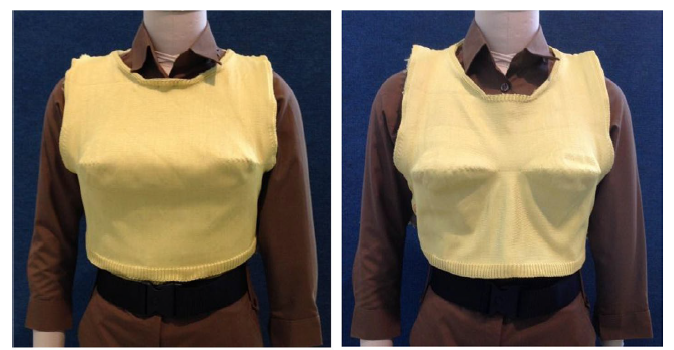When I began this research, my first question was one many people ask: Why isn’t body armor designed to fit a woman’s body better?
The short answer is—it’s not that simple. But the scientists are working on it! Some have experimented with cup shapes woven into Kevlar layers, as shown in the image, but the result has been….well, you can see.

Currently there are two armor shapes: unisex and structured. Unisex armor is a flat, uniform panel. Structured armor, by contrast, incorporates darts to create a concave shape, giving space for the breasts. Armor is made of 10-30 layers of ballistic materials, depending on its threat resistance rating.
Darts are a tailoring technique commonly used in clothing to form room for the bust. They start from the side seam and extend to the bust or start at the waistline and rise up toward the bust. In armor, the darting method depends on the manufacturer. Some fold the material to create shape, while others cut a wedge and sew the edges together. Both approaches increase bulk in the darted area—sometimes doubling the material—resulting in stiffness, bulk, and discomfort in already sensitive areas.
These seams create a potential vulnerability because the needle punctures through the material create a weakness. What works in a dress becomes a ballistic liability in armor. The seam lines that shape a garment also become points of failure in protection unless heavily reinforced, which again adds bulk. During NIJ certification, the seams are shot directly to ensure the seamed area meets the integrity standards.
Ballistic materials behave very differently from garment fabrics. Fashion fabric drapes easily and lightly on the body; ballistic materials do not. Plus, there are 10-30 layers of it stacked together. Imagine trying to shape 20 bedsheets stacked together—they won’t bend or be shaped easily. Now replace those sheets with stiff ballistic fabric and you begin to see the problem. Structured armor can’t truly “fit”; it simply makes room.
So why not mold the armor into a more anatomical shape—something more like what Batman would wear? Because molding diminishes ballistic protection.
Ballistic materials, like Kevlar and Ultra-high Molecular Weight Polyethylene, work by catching and dispersing energy. When a bullet hits the armor, the fine fibers rub together and create friction, which generates heat and spreads the energy laterally. Kevlar absorbs heat, while UHMWPE melts slightly, using that phase change to dissipate energy. If you mold these materials with heat during manufacturing, you use up part of their energy-absorbing capacity before the armor is ever worn.
Designing armor for women isn’t just about tailoring—it’s about physics. Until we develop new materials that can flex, conform, and protect without compromising performance, structured, concave armor will remain the best current solution to a complex problem.
